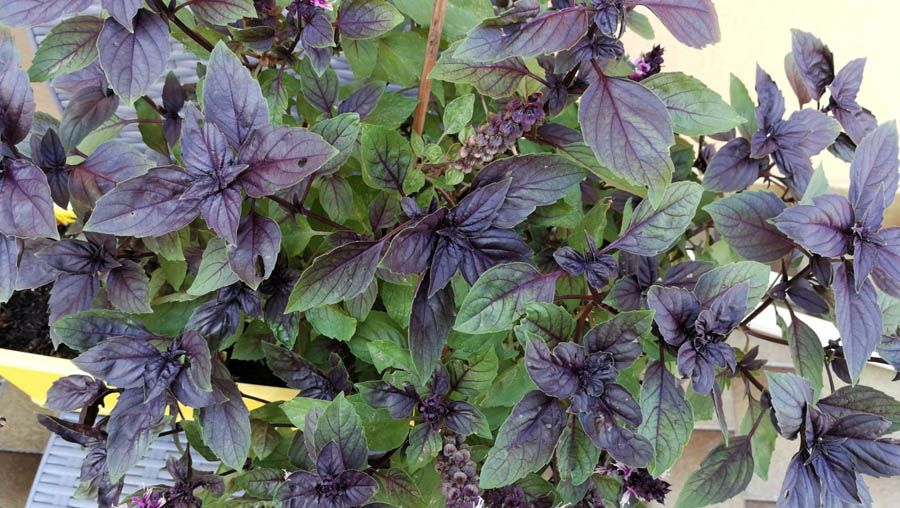Pesto alla Genovese… with red basil!
P e s t o a l l a G e n o v e s e … w i t h r e d b a s i l !
Meanwhile, if you are wondering whether the pesto will have a strange red colour, you need to know that this is not the case: it will always be green, perhaps darker, but still green!
Moreover, be aware that for making the true “Pesto alla Genovese” you will need a marble mortar, a wooden pestle, and… Patience.
However, today we propose an alternative version from the original that also shows the versatility of an excellent product such as Montioni extra virgin olive oil (EVO).
Like any traditional recipe, which is now popular throughout Italy, each family has its own Genovese pesto recipe, and the one we propose is Andrea’s from Venice whom we thank for sharing it with us!
Do you want to use mortar and pestle? Great! But you should know that even a small electric grinder or a low speed blender can be used (possibly with plastic blades, the metal makes the leaves bitter).
Two tips:
– Blend at intervals, that is, blend a few seconds, stop and start again (to reduce oxidation);
– Leave the cup and blades in the fridge before use, the colder they are the less they overheat the pesto, and the less they oxidize it.
Why use red basil instead of the traditional green basil? For its particularly persuasive aroma and especially for its spicy notes. You will feel like you are eating almost a different sauce.
And there’s more! Red basil is also famous for its antiseptic and antioxidant properties, perfect against inflammations affecting during the winter.



Now, at work! Let’s see how this delicious variation of the well-known Pesto alla Genovese is made!
RECIPE: RED BASIL (GENOVESE) PESTO
Ingredients
50 gr red basil (leaves)
40 gr parmesan cheese
20 gr pine nuts
Montioni extra virgin olive oil
½ medium-sized clove garlic
1 pinch of salt
Pairing Between Kitchen and Cellar
Montioni extra virgin olive oil. You cannot make true Italian Pesto alla Genovese without a great extra virgin olive oil.
Montioni oil is also cold pressed and comes from olives that grow in the Umbrian hills. Could it get any better?
Method
Pesto alla Genovese with red basil is an alternative to the classic pesto: it makes the sauce more aromatic and gives it a slightly spicy aftertaste.
A must-try variation!
How to make Pesto alla Genovese with red basil
1) Put the Parmesan (if not grated), the garlic and the pine nuts in the blender until you get a finely chopped mixture.
2) Wash the red basil and place its leaves in the blender, add the Parmesan (if you have the grated one) and part of the oil, then start blending again.
3) As the mixture is minced, add Montioni oil according to your taste. Season with salt.
Our Pesto alla Genovese with red basil is ready!
You can use red basil pesto not only with your pasta dishes as per tradition, but it is also suitable for many other uses in cooking.
Alternative ways to use Red Basil Pesto alla Genovese:
– It can be used as a sauce; a spoonful of pesto on mashed potato will make it flavourful and with an extra touch of taste.
– For total green lasagne, combine the red basil pesto with ricotta to be spread on pasta sheets when layering; also suitable for those who prefer light and vegetarian dishes;
– And how about enhancing a simple egg omelette by adding two tablespoons of red basil pesto during cooking? A delight with very few ingredients!
– Finally, a perfect mix for a good Italian DOC: spread our fragrant pesto on… pizza! Use it instead of tomato puree, or if you are looking for a more delicate taste you can add a tomato, perhaps with some buffalo mozzarella.
What do you think about this red basil pesto? A few simple ingredients for a pesto with an exceptional aroma that can be used in a thousand different ways.
See you next time on the blog of the Azienda Agricola Montioni, Between Kitchen and Cellar!
And don’t forget to send us the recipes of your dishes with photos, we will post them on our blog and Facebook page.

2) Aggiungere un cucchiaino di lievito per dolci, quindi amalgamare.
3) Foderare una teglia con carta da forno
4) Fare con l’impasto dei rotolini e poi unire i due estremi di ciascun rotolino per formare una ciambellina.

5) Ripassare la ciambellina nello zucchero, avanti e dietro, poi disporre sulla teglia.
6) Infornare le ciambelline a 190° per 7 minuti

Ed ecco pronte le nostre ciambelline al Sagrantino Passito Montioni!

L’abbinamento che vi consigliamo? Ovviamente un calice di Sagrantino Passito Montioni o, in alternativa, il nostro vino più amato ovvero il Sagrantino di Montefalco DOCG Montioni!
Alla prossima ricetta del blog dell’Azienda Agricola Montioni, Tra Cucina e Cantina!
On occasion, the winemaker may decide to leave them in if the grapes themselves contain less tannin than desired. This is more acceptable if the stems have ‘ripened’ and started to turn brown. If increased skin extraction is desired, a winemaker might choose to crush the grapes after destemming.
Wine is one of the most civilized things in the world and one of the most natural things of the world that has been brought to the greatest perfection, and it offers a greater range for enjoyment and appreciation than, possibly, any other purely sensory thing.
Ernest Hemingway Tweet
Removal of stems first means no stem tannin can be extracted. In these cases the grapes pass between two rollers which squeeze the grapes enough to separate the skin and pulp, but not so much as to cause excessive shearing or tearing of the skin tissues. In some cases, notably with “delicate” red varietals such as Pinot noir or Syrah, all or part of the grapes might be left uncrushed (called “whole berry”) to encourage the retention of fruity aromas through partial carbonic maceration.
The Grapes
The quality of the grapes determines the quality of the wine more than any other factor. Grape quality is affected by variety as well as weather during the growing season, soil minerals and acidity, time of harvest, and pruning method. The combination of these effects is often referred to as the grape’s terroir.
Grapes are usually harvested from the vineyard from early September until early November in the northern hemisphere, and mid February until early March in the southern hemisphere.
In some cool areas in the southern hemisphere, for example Tasmania, harvesting extends into May. The most common species of wine grape is Vitis Vinifera, which includes nearly all varieties of European origin. The most common species of wine grape is Vitis Vinifera, which includes nearly all varieties of European origin.

Manual harvesting is the hand-picking of grape clusters from the grapevines. In the United States, some grapes are picked into one- or two-ton bins for transport back to the winery. Manual harvesting has the advantage of using knowledgeable labor to not only pick the ripe clusters but also to leave behind the clusters that are not ripe or contain bunch rot or other defects. This can be an effective first line of defense to prevent inferior quality fruit from contaminating a lot or tank of wine.
Destemming is the process of separating stems from the grapes. Depending on the winemaking procedure, this process may be undertaken before crushing with the purpose of lowering the development of tannins and vegetal flavors in the resulting wine. Single berry harvesting, as is done with some German Trockenbeerenauslese, avoids this step altogether with the grapes being individually selected.
Crushing is the process when gently squeezing the berries and breaking the skins to start to liberate the contents of the berries. Destemming is the process of removing the grapes from the rachis (the stem which holds the grapes).
In traditional and smaller-scale wine making, the harvested grapes are sometimes crushed by trampling them barefoot or by the use of inexpensive small scale crushers. These can also destem at the same time. However, in larger wineries, a mechanical crusher/destemmer is used. The decision about destemming is different for red and white wine making. Generally when making white wine the fruit is only crushed, the stems are then placed in the press with the berries. The presence of stems in the mix facilitates pressing by allowing juice to flow past flattened skins.

Katerina Monroe
@katerinam • More Posts by Katerina
Congratulations on the award, it's well deserved! You guys definitely know what you're doing. Looking forward to my next visit to the winery!
